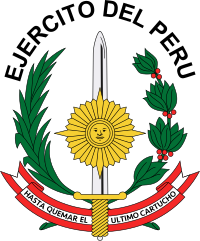Army of Peru
| Peruvian Army Ejército del Perú |
|
|---|---|
 |
|
| Active | 1821–present |
| Country |
|
| Allegiance |
|
| Type | Army |
| Size | 78,400 active personnel 14,000 reserve |
| Motto(s) | Hasta quemar el último cartucho (Until the last cartridge has been fired) |
| Colors | Red and White |
| Anniversaries | December 9, Army Day June 7, Battle of Arica and National Flag Day |
| Engagements |
Peruvian War of Independence Gran Colombia–Peru War War of the Confederation Chincha Islands War War of the Pacific Ecuadorian–Peruvian War Internal conflict in Peru Cenepa War |
| Commanders | |
| Commanding General of the Army | Humberto Ramos Hume |
| Notable commanders |
José de San Martín (founding Commanding General) |
| Insignia | |
| Flag |  |
The Peruvian Army (Spanish: Ejército del Perú, abbreviated EP) is the branch of the Peruvian Armed Forces tasked with safeguarding the independence, sovereignty and integrity of national territory on land through military force. Additional missions include assistance in safeguarding internal security, conducting disaster relief operations and participating in international peacekeeping operations. It celebrates the anniversary of the Battle of Ayacucho (1824) on December 9.
Military traditions in Peruvian territory go back to prehispanic times, ranging from small armed bands to the large armies assembled by the Inca Empire. After the Spanish conquest, small garrisons were kept at strategic locations but no standing army existed until the Bourbon reforms of the 18th century. The main purpose of this force was the defense of the Viceroyalty from pirates and corsairs as well as internal rebellions.
The Ejército del Perú was officially established on August 18, 1821 when the government of general José de San Martín established the Legión Peruana de la Guardia (Peruvian Guard Legion), although some militia units had been formed before. Peruvian troops were key participants in the final campaign against Spanish rule in South America, under the leadership of general Simón Bolívar, which ended victoriously in the battles of Junín and Ayacucho in 1824.
...
Wikipedia
